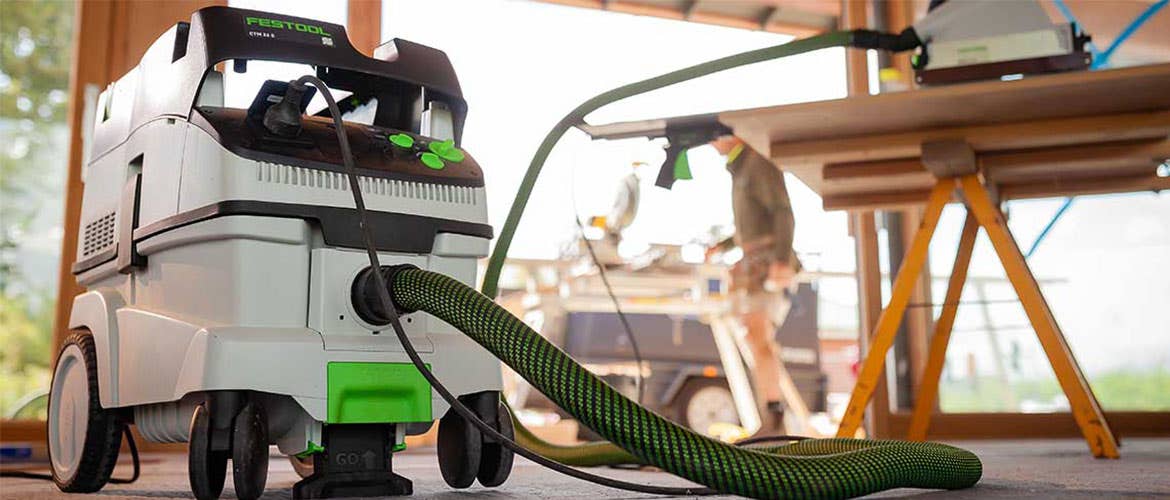In search of the most compact and lightweight M class dust extractor? We have a range of tools to suit, which includes the M-class dust extractor range from Festool.
But before we go into that, let's touch on dust and how the extractors are classified...
What is a dust class and how are the classes set?
A dust class is just a rating of how dangerous certain types of dusts are to humans. They are set based on a) the chemical composition of materials, b) the size of the dust particle, and c) exposure limits. The general rule is the smaller the dust particle, the more dangerous it is because it can travel further into our system and lodge itself in our tissue. And it’s pretty obvious that the longer we’re exposed to such dusts, the greater the risk.
There’s an international standard (IEC 60 335-2-69 if you want to look it up) that categorises all types of dust into three main classes; L, M and H.
What is M Class dust specifically?
It goes L > M > H (lowest to highest) in terms of risk rating, so M Class dust is mid-level. That doesn’t mean it’s not as dangerous as you think though. It includes dust from hard woods, board materials, some paints, concrete and bricks. M Class also includes something you’ve probably heard of, crystalline silica dust, which is found in sand, stone, concrete and mortar.
What is required of a dust extractor to be approved for M Class dust?
All M Class dust extractors have passed testing at the point of manufacture that proves they capture no less than 99.9% of dust. This means you can't 'upgrade' a dust extractor from one class to another.
What’s the go for M Class then?
You’ll find that suction levels between L and M Class extractors are very similar. An M Class extractor however will have superior filtration and a flow sensor / alarm that alerts the user to a drop in suction rate caused by things like a blocked hose or full dust bag.
So, to put it simply, you take an L Class dust extractor, add a flow sensor / alarm and an M Class filter, and you’ve got an M Class dust extractor.
Or, for all Autoclean dust extractors, add a flow sensor / alarm and a high performance filter, and you’ve got an M Class dust extractor.
However, for THE BEST performance, there are a few other functions you’ll want. They are:
-
‘Auto-start’ and ‘delayed shut-off’ for power tools, which saves you turning two things on at the same and ensures ALL dust is properly and efficiently captured
-
Automatic filter cleaning that keeps the filter clear and maintains maximum performance while preventing premature motor burn-out
-
Capability for wet and dry materials, but you need to change or remove the filter and dust bag depending on the material
Festool M-class dust extractor vacuums available at NHS
The Festool range of M-class dust extractor vacuums are lightweight yet powerful and perfectly suited for on-site extraction for electric power tools for sanding, routing, sawing and drilling work. Festool M class dust extractors are also ideal for mobile work or any job that requires compact and easy to handle machinery.
Say hello to adjustable suction power and the switch on/shut off function which allows their extractors to turn on automatically when required and turn off when not. Approved for dust class M, and with the option of fitting air modules, Festool's range of dust extractors promise healthy, dust free working conditions at every job. Choose from the CTM 36l M Class Autoclean Dust Extractor, CTM MIDI-2 15l M Class Dust Extractor or CTM 26l M Class Dust Extractor -- there is no job that is too big for Festool's specially designed dust extractors!
Shop online now for the Festool Dust Extractors
FESTOOL CT 36L AUTOCLEAN M-CLASS DUST EXTRACTOR
FESTOOL CT MIDI 15L M-CLASS DUST EXTRACTOR
Disclaimer: This information is not endorsed by any Work Health and Safety governing body and shouldn't be interpreted as any form of legal or health advice. All regulatory and compliance enquiries must go to the relevant Worksafe organisation responsible for each region of Australia. All health-based enquiries should be discussed with and handled by a Medical Professional.


